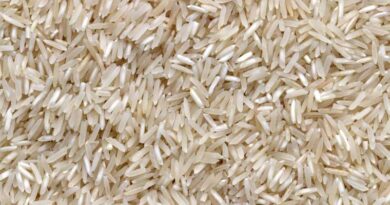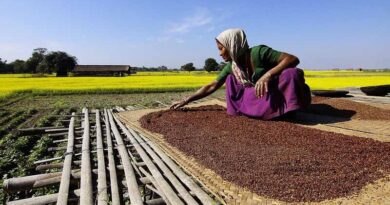
India Reports Strong Kharif Sowing Surge in 2025 with 262 Lakh Hectares Covered
02 July 2025, New Delhi: The Ministry of Agriculture & Farmers’ Welfare has released the progress of kharif crop sowing across India as of 27th June 2025, highlighting a significant year-on-year increase in the total area covered under cultivation. The cumulative kharif sowing this season has reached 262.15 lakh hectares, marking an increase of 26.71 lakh hectares compared to the same period last year.
This early season progress indicates a robust start to the kharif marketing year, with favourable monsoon patterns contributing to an uptick in the sowing activity across most major crop categories.
Rice Cultivation Witnesses Strong Momentum
Rice, the primary kharif crop, has recorded a sharp rise in sowing area. As of 27th June 2025, 35.02 lakh hectares have been sown under rice, a substantial increase from 23.78 lakh hectares in the previous year—registering a growth of 11.24 lakh hectares. With a normal area of 403.09 lakh hectares based on the five-year average (2019–2024), the current figures suggest that farmers have advanced their sowing operations significantly ahead of schedule.
Pulses Register Positive Growth, Moong Bean Sees Surge
Total area under pulses has reached 21.09 lakh hectares, up from 15.37 lakh hectares last year—an increase of 5.73 lakh hectares. Among individual pulse varieties:
- Moong bean has emerged as a standout performer with 8.58 lakh hectares sown, nearly doubling from last year’s 4.30 lakh hectares, marking a jump of 4.28 lakh hectares.
- Urd bean coverage rose to 2.35 lakh hectares, up by 0.93 lakh hectares.
- Arhar (Tur) declined marginally to 8.35 lakh hectares, a slight dip of 0.32 lakh hectares.
- Moth bean also recorded a notable expansion to 0.56 lakh hectares, up from a negligible 0.01 lakh hectares in 2024.
- Kulthi (horse gram) and other pulses also saw minor gains.
These figures reflect growing farmer interest in diversified pulse cultivation, likely influenced by rising market prices and government procurement assurances.
Coarse Cereals (Shri Anna) Advance Steadily
The area under coarse cereals, which include Shri Anna crops such as millets and maize, has reached 41.75 lakh hectares, up from 35.01 lakh hectares last year. The rise of 6.74 lakh hectares is driven mainly by:
- Maize, which continues to dominate the segment with 23.69 lakh hectares, up 2.34 lakh hectares from 2024.
- Bajra (pearl millet) rose to 14.76 lakh hectares, marking a growth of 4.36 lakh hectares.
- Jowar (sorghum) also increased to 2.70 lakh hectares.
However, Ragi and Small Millets saw a contraction of 0.83 lakh hectares and 0.29 lakh hectares respectively, pointing to a possible shift in farmer preference toward higher-return cereal options.
Oilseeds: Groundnut Leads as Total Area Grows by 8.17 Lakh Hectares
Kharif oilseed crops have shown a strong upward trend this year. As of the latest data, 48.99 lakh hectares have been brought under oilseeds, compared to 40.82 lakh hectares last year—an 8.17 lakh hectare increase.
The boost is largely led by:
- Groundnut, which has nearly doubled to 15.79 lakh hectares, up by 7.65 lakh hectares from the previous year.
- Soybean continues to hold ground as the major oilseed crop with 32.04 lakh hectares, marginally higher than last year.
- Sesamum and Sunflower also posted small gains, while Castor declined slightly.
- Niger remains negligible in area sown so far.
The overall increase reflects a positive farmer sentiment toward oilseeds, likely influenced by strong market prices and export opportunities.
Sugarcane and Cotton Show Mixed Trends
Sugarcane, with a normal planting window extending into earlier months, has recorded 55.16 lakh hectares of area coverage—0.29 lakh hectares higher than the previous year. The crop continues to retain a stable share in the kharif portfolio.
In contrast, cotton sowing has seen a contraction, dropping to 54.66 lakh hectares from 59.97 lakh hectares last year—marking a decline of 5.31 lakh hectares. The dip may be attributed to shifting farmer preferences or delays in sowing in some states.
Jute and Mesta Decline Marginally
The area under Jute and Mesta has fallen slightly to 5.47 lakh hectares, compared to 5.62 lakh hectares during the same period last year. Though the decline is minor (0.15 lakh hectares), it may signal the need for renewed interventions to sustain fibre crop cultivation in eastern India.
Progress of Area Coverage under Kharif Crops in India (as on 27th June 2025) (Area in lakh hectares)
| S. No. | Crop | Normal Area (Avg. 2019–2024) | Area Sown (2025) | Area Sown (2024) | Change Over 2024 |
|---|---|---|---|---|---|
| 1 | Rice | 403.09 | 35.02 | 23.78 | +11.24 |
| 2 | Pulses | 129.61 | 21.09 | 15.37 | +5.73 |
| a. Arhar (Tur) | 44.71 | 8.35 | 8.67 | -0.32 | |
| b. Urd bean | 32.64 | 2.35 | 1.42 | +0.93 | |
| c. Moong bean | 35.69 | 8.58 | 4.30 | +4.28 | |
| d. Kulthi | 1.72 | 0.09 | 0.07 | +0.02 | |
| e. Moth bean | 9.70 | 0.56 | 0.01 | +0.55 | |
| f. Other Pulses | 5.15 | 1.17 | 0.89 | +0.27 | |
| 3 | Shri Anna / Coarse Cereals | 180.71 | 41.75 | 35.01 | +6.74 |
| a. Jowar | 15.07 | 2.70 | 1.53 | +1.16 | |
| b. Bajra | 70.69 | 14.76 | 10.40 | +4.36 | |
| c. Ragi | 11.52 | 0.08 | 0.91 | -0.83 | |
| d. Small Millets | 4.48 | 0.53 | 0.82 | -0.29 | |
| e. Maize | 78.95 | 23.69 | 21.35 | +2.34 | |
| 4 | Oilseeds | 194.63 | 48.99 | 40.82 | +8.17 |
| a. Groundnut | 45.10 | 15.79 | 8.14 | +7.65 | |
| b. Soybean | 127.19 | 32.04 | 31.78 | +0.26 | |
| c. Sunflower | 1.29 | 0.39 | 0.37 | +0.02 | |
| d. Sesamum | 10.32 | 0.69 | 0.43 | +0.26 | |
| e. Niger | 1.08 | 0.00 | 0.01 | 0.00 | |
| f. Castor | 9.65 | 0.04 | 0.06 | -0.02 | |
| g. Other Oilseeds | 0.00 | 0.04 | 0.04 | 0.00 | |
| 5 | Sugarcane | 52.51 | 55.16 | 54.88 | +0.29 |
| 6 | Jute & Mesta | 6.59 | 5.47 | 5.62 | -0.15 |
| 7 | Cotton | 129.50 | 54.66 | 59.97 | -5.31 |
| Total | 1096.64 | 262.15 | 235.44 | +26.71 |
Also Read: Syngenta to Become Global Leader in Biologicals; Expanding Nature Inspired Solutions for Farmers
📢 If You’re in Agriculture, Make Sure the Right People Hear Your Story.
From product launches to strategic announcements, Global Agriculture offers unmatched visibility across international agri-business markets. Connect with us at pr@global-agriculture.com to explore editorial and advertising opportunities that reach the right audience, worldwide.






